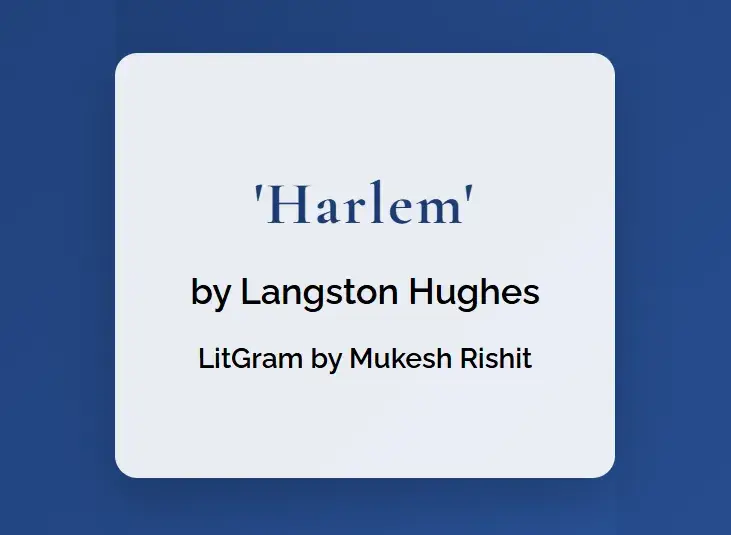Introduction
Langston Hughes’ poem “Harlem,” also known as “Dream Deferred,” stands as a poignant and powerful exploration of the consequences of unrealized dreams. Written in 1951 during the Harlem Renaissance, this short but impactful poem uses vivid imagery and thought-provoking questions to examine the effects of systemic racism and economic inequality on the African American community. Through his masterful use of language and metaphor, Hughes invites readers to consider the explosive potential of dreams long delayed.
The Central Question
At the heart of “Harlem” lies a fundamental question that sets the tone for the entire poem:
What happens to a dream deferred?
This opening line immediately engages the reader, prompting them to consider the fate of unfulfilled aspirations. Hughes doesn’t provide a simple answer but instead offers a series of vivid possibilities, each more unsettling than the last.
The Power of Imagery
Dreams as Tangible Objects
Hughes employs a series of similes that transform the abstract concept of a dream into tangible, sensory experiences:
Does it dry up like a raisin in the sun?
This first simile suggests a process of withering and diminishment. The image of a raisin – once a plump, juicy grape – drying in the sun evokes a sense of lost potential and vitality.
The Festering Sore
Hughes then takes a more visceral turn:
Or fester like a sore— And then run?
This graphic image suggests that unfulfilled dreams can become a source of pain and infection, potentially spreading their negative impact beyond the individual to the broader community.
The Stench of Rot
The poem continues with another powerful olfactory image:
Does it stink like rotten meat?
This simile evokes a sense of disgust and decay, implying that dreams denied for too long can become a source of bitterness and resentment.
The Sugary Crust
Hughes then offers a deceptively sweet image:
Or crust and sugar over— like a syrupy sweet?
This simile suggests that some dreams might develop a false exterior, hiding the disappointment beneath a saccharine surface. It could be interpreted as a commentary on forced contentment or the masking of true feelings.
The Burden of Unfulfilled Dreams
The Weight of Dreams
Hughes introduces a sense of physical burden:
Maybe it just sags like a heavy load.
This image conveys the exhaustion and strain of carrying unrealized aspirations. It suggests that the weight of deferred dreams can be a constant presence, wearing down the dreamer over time.
The Explosive Potential
The Final, Ominous Possibility
The poem concludes with a single, powerful line set apart from the rest:
Or does it explode?
This abrupt ending serves as a warning and a call to action. It suggests that the continuous deferral of dreams – particularly those of an entire community – can lead to sudden, potentially violent consequences.
Literary Techniques in “Harlem”
Hughes employs several literary techniques to convey his message effectively:
Rhythm and Structure
The poem’s short lines and use of questions create a rhythmic, almost musical quality. This structure mirrors the stop-and-start nature of progress, reflecting the frustration of deferred dreams.
Alliteration and Assonance
Hughes uses alliteration in phrases like “does it dry” and assonance in “sun/run,” enhancing the poem’s musicality and emphasizing key words.
Escalating Imagery
The images in the poem escalate from mild (a dried raisin) to severe (explosion), creating a sense of building tension that reflects the growing frustration of unfulfilled dreams.
Historical and Social Context
The Harlem Renaissance
“Harlem” was written during the latter part of the Harlem Renaissance, a period of great cultural and artistic flourishing in the African American community. However, it also reflects the ongoing struggles and inequalities faced by Black Americans.
Civil Rights Movement
Published just a few years before the Montgomery Bus Boycott, the poem can be seen as a precursor to the Civil Rights Movement, warning of the consequences of continued racial inequality.
The Universal Appeal of “Harlem”
While rooted in the specific experiences of African Americans in the mid-20th century, “Harlem” speaks to a universal human experience. Everyone has had dreams deferred at some point, making the poem’s exploration of frustration and potential consequences relatable across cultures and generations.
The Enduring Relevance of Hughes’ Message
Decades after its publication, “Harlem” remains startlingly relevant. In a world where inequality and systemic barriers continue to defer the dreams of many, Hughes’ words serve as both a warning and a call to action.
Conclusion
“Harlem” stands as a testament to Langston Hughes’ ability to distill complex social issues into powerful, evocative language. Through its vivid imagery and probing questions, the poem forces readers to confront the consequences of a society that consistently defers the dreams of some of its members.
Hughes’ masterpiece serves as a reminder of the power of dreams and the danger of their continual deferment. It challenges us to consider the dreams we hold individually and collectively, and to work towards a world where no one’s aspirations are left to dry up, fester, or explode. In its brief lines, “Harlem” encapsulates both the hope and frustration of the human experience, making it a timeless piece of literature that continues to resonate and inspire.



2 Comments
I think other web site proprietors should take this site as an model, very clean and great user genial style and design, let alone the content. You’re an expert in this topic!
Pingback: Soul Gone Home Summary: A Complete Analysis of Langston Hughes' One-Act Play